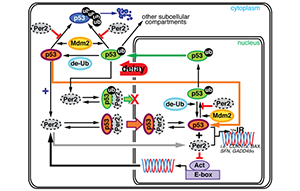Professor Jae Kyoung Kim of the Department of Mathematical Sciences recently created a mathematical model that predicts the distribution of p53, a cell growth inhibitor, during a 24-hour period that correlates to the circadian clock. His model was proven to be accurate by experiments conducted by Virginia Tech Professor Carla Finkielstein and her research team, concluding that biological clocks and cancer are strongly interrelated by the amounts of p53 in the system.
In 2014, Professor Kim met with Professor Finkielstein to discuss her concerns that her research did not present any strong clues as to which factors determined the cycle of p53 distribution. This is because the process of cell growth inhibition by p53 is very complicated, and therefore attempts to understand such a complex system was only possible with rigorous experimentation done over long periods of time with many researchers.

Professor Kim solved those issues by conducting over a million trials of computer simulation based on his mathematical model rather than conducting traditional experiments. His study showed that the presence of Period2, an important protein for circadian rhythms, had deep connections with the distribution of p53 throughout the circadian cycle.
Cell growth inhibition occurs in the presence of p53 in cell nuclei. Professor Kim accurately predicted that the Period2 protein played a major role in dragging the inhibitor molecule into the nucleus. This provided an explanation as to why consuming anti-cancer drugs at different times resulted in different effects, and provided deep insights into figuring out the optimal time to consume such drugs.
Professor Kim exclaimed, “I am delighted that I can make the lives of nurses, policemen, and other professions with night shifts healthier and happier with my knowledge on mathematics.” The circadian cycle affects everyday life such that biological signals consistently go through a cycle with a period of 24 hours. Breaking or altering this cycle is known to result in higher chances of getting diabetes, cancer, and heart diseases. He also mentioned that he was “looking forward to the more active exchange of information between mathematics and biology, which our country currently lacks, that this finding could lead to”.

